Deck 24: Electric Potential
Question
Question
Question
Question
Question
Question
Question
Question
Question
Question
Question
Question
Question
Question
Question
Question
Question
Question
Question
Question
Question
Question
Question
Question
Question
Question
Question
Question
Question
Question
Question
Question
Question
Question
Question
Question
Question
Question
Question
Question
Question
Question
Question
Question
Question
Question
Question
Question
Question
Question
Question
Question
Question
Question
Question

Unlock Deck
Sign up to unlock the cards in this deck!
Unlock Deck
Unlock Deck
1/55
Play
Full screen (f)
Deck 24: Electric Potential
1
Two large parallel conducting plates are separated by a distance d, placed in a vacuum, and connected to a source of potential difference V.An oxygen ion, with charge 2e, starts from rest on the surface of one plate and accelerates to the other.If e denotes the magnitude of the electron charge, the final kinetic energy of this ion is:
A)eV/2
B)eV/d
C)eVd
D)Vd/e
E)2eV
A)eV/2
B)eV/d
C)eVd
D)Vd/e
E)2eV
2eV
2
During a lightning discharge, 30 C of charge move through a potential difference of 1.0 *108 V in 2.0 *10-2 s.The energy released by this lightning bolt is:
A)1.5 * 1011 J
B)3.0 * 109 J
C)6.0 * 107 J
D)3.3 *106 J
E)1500 J
A)1.5 * 1011 J
B)3.0 * 109 J
C)6.0 * 107 J
D)3.3 *106 J
E)1500 J
3.0 * 109 J
3
The potential difference between the ends of a 2-meter stick that is parallel to a uniform electric field is 400 V.The magnitude of the electric field is:
A)0 V/m
B)100 V/m
C)200 V/m
D)400 V/m
E)800 V/m
A)0 V/m
B)100 V/m
C)200 V/m
D)400 V/m
E)800 V/m
200 V/m
4
The work required to carry a particle with a charge of 6.0-µC from a 5.0-V equipotential surface to a 6.0-V equipotential surface and back again to the 5.0-V surface is:
A)0 J
B)1.2 *10-5 J
C)3.0* 10-5 J
D)6.0 *10-5 J
E)6.0 * 10-6 J
A)0 J
B)1.2 *10-5 J
C)3.0* 10-5 J
D)6.0 *10-5 J
E)6.0 * 10-6 J

Unlock Deck
Unlock for access to all 55 flashcards in this deck.
Unlock Deck
k this deck
5
A particle with mass m and charge -q is projected with speed v0 into the region between two parallel plates as shown.The potential difference between the two plates is V and their separation is d.The change in kinetic energy of the particle as it traverses this region is: 
A)-qV/d
B)
C)qV
D)
E)none of these

A)-qV/d
B)

C)qV
D)

E)none of these

Unlock Deck
Unlock for access to all 55 flashcards in this deck.
Unlock Deck
k this deck
6
An electron moves from point i to point f, in the direction of a uniform electric field.During this motion: 
A)the work done by the field is positive and the potential energy of the electron-field system increases
B)the work done by the field is negative and the potential energy of the electron-field system increases
C)the work done by the field is positive and the potential energy of the electron-field system decreases
D)the work done by the field is negative and the potential energy of the electron-field system decreases
E)the work done by the field is positive and the potential energy of the electron-field system does not change

A)the work done by the field is positive and the potential energy of the electron-field system increases
B)the work done by the field is negative and the potential energy of the electron-field system increases
C)the work done by the field is positive and the potential energy of the electron-field system decreases
D)the work done by the field is negative and the potential energy of the electron-field system decreases
E)the work done by the field is positive and the potential energy of the electron-field system does not change

Unlock Deck
Unlock for access to all 55 flashcards in this deck.
Unlock Deck
k this deck
7
Protons in the LHC accelerator in Geneva, Switzerland are accelerated to an energy of 4.0 TeV.What is this in joules?
A)6.4 x 10-19 J
B)6.4 x 10-16 J
C)6.4 x 10-13 J
D)6.4 x 10-10 J
E)6.4 x 10-7 J
A)6.4 x 10-19 J
B)6.4 x 10-16 J
C)6.4 x 10-13 J
D)6.4 x 10-10 J
E)6.4 x 10-7 J

Unlock Deck
Unlock for access to all 55 flashcards in this deck.
Unlock Deck
k this deck
8
An electron has charge -e and mass me.A proton has charge e and mass 1840me.A "proton volt" is equal to:
A)1eV
B)1840eV
C)(1/1840)eV
D) eV
eV
E)(1/ )eV
)eV
A)1eV
B)1840eV
C)(1/1840)eV
D)
 eV
eVE)(1/
 )eV
)eV
Unlock Deck
Unlock for access to all 55 flashcards in this deck.
Unlock Deck
k this deck
9
The potential difference between two points is 100 V.If a particle with a charge of 2 C is transported from one of these points to the other, the magnitude of the work done is:
A)200 J
B)100 J
C)50 J
D)100 V
E)2 J
A)200 J
B)100 J
C)50 J
D)100 V
E)2 J

Unlock Deck
Unlock for access to all 55 flashcards in this deck.
Unlock Deck
k this deck
10
The Earth's electric field creates a potential that increases 100 V for every meter of altitude.If an object of charge +4.5 mC and mass 68 g falls a distance of 1.0 m from rest under the influence of the Earth's electric and gravitational fields, what is its final kinetic energy?
A)0.22 J
B)0.45 J
C)0.67 J
D)1.1 J
E)7.2 J
A)0.22 J
B)0.45 J
C)0.67 J
D)1.1 J
E)7.2 J

Unlock Deck
Unlock for access to all 55 flashcards in this deck.
Unlock Deck
k this deck
11
An electron volt is:
A)the force acting on an electron in a field of 1 N/C
B)the force required to move an electron 1 meter
C)the energy gained by an electron in moving through a potential difference of 1 volt
D)the energy needed to move an electron through 1 meter in any electric field
E)the work done when 1 coulomb of charge is moved through a potential difference of 1 volt
A)the force acting on an electron in a field of 1 N/C
B)the force required to move an electron 1 meter
C)the energy gained by an electron in moving through a potential difference of 1 volt
D)the energy needed to move an electron through 1 meter in any electric field
E)the work done when 1 coulomb of charge is moved through a potential difference of 1 volt

Unlock Deck
Unlock for access to all 55 flashcards in this deck.
Unlock Deck
k this deck
12
An electron goes from one equipotential surface to another along one of the four paths shown below.Rank the paths according to the work done by the electric field, from least to greatest. 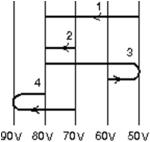
A)1, 2, 3, 4
B)4, 3, 2, 1
C)1, then 3, then 4 and 2 tie
D)4 and 2 tie, then 3, then 1
E)4, 3, 1, 2

A)1, 2, 3, 4
B)4, 3, 2, 1
C)1, then 3, then 4 and 2 tie
D)4 and 2 tie, then 3, then 1
E)4, 3, 1, 2

Unlock Deck
Unlock for access to all 55 flashcards in this deck.
Unlock Deck
k this deck
13
If 500 J of work are required to carry a 40-C charge from one point to another, the potential difference between these two points is:
A)12.5 V
B)20,000 V
C)0.08 V
D)depends on the path
E)none of these
A)12.5 V
B)20,000 V
C)0.08 V
D)depends on the path
E)none of these

Unlock Deck
Unlock for access to all 55 flashcards in this deck.
Unlock Deck
k this deck
14
A tiny sphere carrying a charge of 6.5 µC sits in an electric field, at a point where the electric potential is 240 V.What is the sphere's potential energy?
A)2.7 x 10-8 J
B)6.5 x 10-6 J
C)1.6 x 10-3 J
D)240 J
E)3.7 x 107 J
A)2.7 x 10-8 J
B)6.5 x 10-6 J
C)1.6 x 10-3 J
D)240 J
E)3.7 x 107 J

Unlock Deck
Unlock for access to all 55 flashcards in this deck.
Unlock Deck
k this deck
15
If the electric field is in the positive x direction and has a magnitude given by E = Cx2, where C is a constant, then the electric potential is given by V =
A)2Cx
B)-2Cx
C)Cx3/3
D)-Cx3/3
E)-3Cx3
A)2Cx
B)-2Cx
C)Cx3/3
D)-Cx3/3
E)-3Cx3

Unlock Deck
Unlock for access to all 55 flashcards in this deck.
Unlock Deck
k this deck
16
An electrically charged object creates an electric field.The electric potential due to this object:
A)is a vector that points either towards or away from the object, depending on the sign of the charge
B)is a vector that makes circular paths around the object
C)is a non-negative scalar
D)is a scalar but will be positive or negative depending on the sign of the charge
E)points in the same direction as the field
A)is a vector that points either towards or away from the object, depending on the sign of the charge
B)is a vector that makes circular paths around the object
C)is a non-negative scalar
D)is a scalar but will be positive or negative depending on the sign of the charge
E)points in the same direction as the field

Unlock Deck
Unlock for access to all 55 flashcards in this deck.
Unlock Deck
k this deck
17
The electric field in a region around the origin is given by  , where C is a constant.The equipotential surfaces are:
, where C is a constant.The equipotential surfaces are:
A)concentric cylinders with axes along the z axis
B)concentric cylinders with axes along the x axis
C)concentric spheres centered at the origin
D)planes parallel to the xy plane
E)planes parallel to the yz plane
 , where C is a constant.The equipotential surfaces are:
, where C is a constant.The equipotential surfaces are:A)concentric cylinders with axes along the z axis
B)concentric cylinders with axes along the x axis
C)concentric spheres centered at the origin
D)planes parallel to the xy plane
E)planes parallel to the yz plane

Unlock Deck
Unlock for access to all 55 flashcards in this deck.
Unlock Deck
k this deck
18
The fact that we can define electric potential energy means that:
A)the electric force is nonconservative
B)the electric force is conservative
C)the work done on a charged particle depends on the path it takes
D)there is a point where the electric potential energy is exactly zero
E)it takes work for the electric force to move from some point a to some other point b and back again
A)the electric force is nonconservative
B)the electric force is conservative
C)the work done on a charged particle depends on the path it takes
D)there is a point where the electric potential energy is exactly zero
E)it takes work for the electric force to move from some point a to some other point b and back again

Unlock Deck
Unlock for access to all 55 flashcards in this deck.
Unlock Deck
k this deck
19
The diagram shows four pairs of large parallel conducting plates.The value of the electric potential is given for each plate.Rank the pairs according to the magnitude of the electric field between the plates, least to greatest. 
A)1, 2, 3, 4
B)4, 3, 2, 1
C)2, 3, 1, 4
D)2, 4, 1, 3
E)3, 2, 4, 1

A)1, 2, 3, 4
B)4, 3, 2, 1
C)2, 3, 1, 4
D)2, 4, 1, 3
E)3, 2, 4, 1

Unlock Deck
Unlock for access to all 55 flashcards in this deck.
Unlock Deck
k this deck
20
An electron is accelerated from rest through a potential difference V.Its final speed is proportional to:
A)V
B)V2
C)
D)1/V
E)1/
A)V
B)V2
C)

D)1/V
E)1/


Unlock Deck
Unlock for access to all 55 flashcards in this deck.
Unlock Deck
k this deck
21
A geologist measures the Earth's electric field near the surface, and finds that equipotential lines 100 V apart are at a distance of 75 cm from each other.Assuming the electric field is uniform, what is its magnitude?
A)130 V/m
B)100 V/m
C)75 V/m
D)1.3 V/m
E)0.75 V/m
A)130 V/m
B)100 V/m
C)75 V/m
D)1.3 V/m
E)0.75 V/m

Unlock Deck
Unlock for access to all 55 flashcards in this deck.
Unlock Deck
k this deck
22
The equipotential surfaces associated with a charged point particle are:
A)radially outward from the particle
B)vertical planes
C)horizontal planes
D)concentric spheres centered at the particle
E)concentric cylinders with the particle on the axis
A)radially outward from the particle
B)vertical planes
C)horizontal planes
D)concentric spheres centered at the particle
E)concentric cylinders with the particle on the axis

Unlock Deck
Unlock for access to all 55 flashcards in this deck.
Unlock Deck
k this deck
23
Eight identical spherical raindrops are each at a potential V, relative to the potential far away.They coalesce to make one spherical raindrop whose potential is:
A)V/8
B)V/2
C)2V
D)4V
E)8V
A)V/8
B)V/2
C)2V
D)4V
E)8V

Unlock Deck
Unlock for access to all 55 flashcards in this deck.
Unlock Deck
k this deck
24
A particle with charge q is to be brought from far away to a point near an electric dipole.No work is done if the final position of the particle is on:
A)the line through the charges of the dipole
B)a line that is perpendicular to the dipole moment
C)a line that makes an angle of 45 ° with the dipole moment
D)a line that makes an angle of 30 ° with the dipole moment
E)none of the above
A)the line through the charges of the dipole
B)a line that is perpendicular to the dipole moment
C)a line that makes an angle of 45 ° with the dipole moment
D)a line that makes an angle of 30 ° with the dipole moment
E)none of the above

Unlock Deck
Unlock for access to all 55 flashcards in this deck.
Unlock Deck
k this deck
25
In the diagram, the points 1, 2, and 3 are all the same very large distance from a dipole.Rank the points according to the values of the electric potential at them, from the most negative to the most positive. 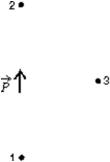
A)1, 2, 3
B)3, 2, 1
C)2, 3, 1
D)1, 3, 2
E)1 and 2 tie, then 3

A)1, 2, 3
B)3, 2, 1
C)2, 3, 1
D)1, 3, 2
E)1 and 2 tie, then 3

Unlock Deck
Unlock for access to all 55 flashcards in this deck.
Unlock Deck
k this deck
26
A total charge of 7 * 10-8 C is uniformly distributed throughout a non-conducting sphere with a radius of 5 cm.The electric potential at the surface, relative to the potential far away, is about:
A)-1.3* 104 V
B)1.3 *104 V
C)630 V
D)130 V
E)0 V
A)-1.3* 104 V
B)1.3 *104 V
C)630 V
D)130 V
E)0 V

Unlock Deck
Unlock for access to all 55 flashcards in this deck.
Unlock Deck
k this deck
27
The electric potential in a certain region of space is given by V = -7.5x2 + 3x, where V is in volts and x is in meters.In this region the equipotential surfaces are:
A)planes parallel to the x axis
B)planes parallel to the yz plane
C)concentric spheres centered at the origin
D)concentric cylinders with the x axis as the cylinder axis
E)unknown unless the charge is given
A)planes parallel to the x axis
B)planes parallel to the yz plane
C)concentric spheres centered at the origin
D)concentric cylinders with the x axis as the cylinder axis
E)unknown unless the charge is given

Unlock Deck
Unlock for access to all 55 flashcards in this deck.
Unlock Deck
k this deck
28
Compared to the magnitude of the electric potential far from a point charge, the magnitude of the electric potential far from an electric dipole:
A)decreases more slowly with distance
B)decreases more quickly with distance
C)increases more slowly with distance
D)increases more quickly with distance
E)varies in the same way with distance
A)decreases more slowly with distance
B)decreases more quickly with distance
C)increases more slowly with distance
D)increases more quickly with distance
E)varies in the same way with distance

Unlock Deck
Unlock for access to all 55 flashcards in this deck.
Unlock Deck
k this deck
29
Positive charge is distributed uniformly throughout a non-conducting sphere.The highest electric potential occurs:
A)at the center
B)at the surface
C)halfway between the center and surface
D)just outside the surface
E)far from the sphere
A)at the center
B)at the surface
C)halfway between the center and surface
D)just outside the surface
E)far from the sphere

Unlock Deck
Unlock for access to all 55 flashcards in this deck.
Unlock Deck
k this deck
30
In a certain region of space the electric potential increases uniformly from east to west and does not vary in any other direction.The electric field:
A)points east and varies with position
B)points east and does not vary with position
C)points west and varies with position
D)points west and does not vary with position
E)points north and does not vary with position
A)points east and varies with position
B)points east and does not vary with position
C)points west and varies with position
D)points west and does not vary with position
E)points north and does not vary with position

Unlock Deck
Unlock for access to all 55 flashcards in this deck.
Unlock Deck
k this deck
31
The graph shows the electric field as a function of position in a particular region of space.If Exs = 100 N/C, what is the potential difference between x = 3 m and x = 6 m? 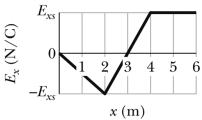
A)250 V
B)50 V
C)0 V
D)-50 V
E)-250 V

A)250 V
B)50 V
C)0 V
D)-50 V
E)-250 V

Unlock Deck
Unlock for access to all 55 flashcards in this deck.
Unlock Deck
k this deck
32
A particle with a charge of 5.5 *10-8C is fixed at the origin.A particle with a charge of -2.3 *10-8C is moved from x = 3.5 cm on the x axis to y = 4.3 cm on the y axis.The change in potential energy of the two-particle system is:
A)3.1 *10-3 J
B)-3.1 * 10-3 J
C)6.0 * 10-5 J
D)-6.0 *10-5 J
E)0 J
A)3.1 *10-3 J
B)-3.1 * 10-3 J
C)6.0 * 10-5 J
D)-6.0 *10-5 J
E)0 J

Unlock Deck
Unlock for access to all 55 flashcards in this deck.
Unlock Deck
k this deck
33
The electric potential at a certain point is given by V = -7.5x2 + 3x, where V is in volts and x is in meters.What is the electric field at that point?
A) = (15x - 3)
= (15x - 3)

B) = (-15x + 3)
= (-15x + 3)

C) = (-2.5x3 + 1.5 x2)
= (-2.5x3 + 1.5 x2)

D) = (2.5x3 - 1.5 x2)
= (2.5x3 - 1.5 x2)

E) = 0
= 0
A)
 = (15x - 3)
= (15x - 3)
B)
 = (-15x + 3)
= (-15x + 3)
C)
 = (-2.5x3 + 1.5 x2)
= (-2.5x3 + 1.5 x2)
D)
 = (2.5x3 - 1.5 x2)
= (2.5x3 - 1.5 x2)
E)
 = 0
= 0
Unlock Deck
Unlock for access to all 55 flashcards in this deck.
Unlock Deck
k this deck
34
A particle with a charge of 5.5 *10-6 C is 3.5 cm from a particle with a charge of -2.3 *10-8 C.The potential energy of this two-particle system, relative to the potential energy at infinite separation, is:
A)3.3 * 10-2 J
B)-3.3 * 10-2 J
C)9.3 * 10-1 J
D)-9.3 * 10-1 J
E)0 J
A)3.3 * 10-2 J
B)-3.3 * 10-2 J
C)9.3 * 10-1 J
D)-9.3 * 10-1 J
E)0 J

Unlock Deck
Unlock for access to all 55 flashcards in this deck.
Unlock Deck
k this deck
35
Two particles with charges Q and -Q are fixed at the vertices of an equilateral triangle with sides of length a.If k = 1/4  , the work required to move a particle with a charge q from the other vertex to the center of the line joining the fixed charges is:
, the work required to move a particle with a charge q from the other vertex to the center of the line joining the fixed charges is: 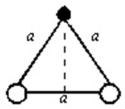
A)0
B)kQq/a
C)kQq/a2
D)2kQq/a
E)
 , the work required to move a particle with a charge q from the other vertex to the center of the line joining the fixed charges is:
, the work required to move a particle with a charge q from the other vertex to the center of the line joining the fixed charges is: 
A)0
B)kQq/a
C)kQq/a2
D)2kQq/a
E)


Unlock Deck
Unlock for access to all 55 flashcards in this deck.
Unlock Deck
k this deck
36
The graph shows the electric potential as a function of x in a certain region.What is the x component of the electric field in this region if Vs = 50 V? 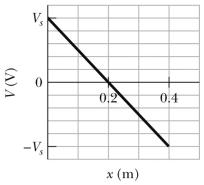
A)250 V/m
B)40 V/m
C)10 V/m
D)-40 V/m
E)-250 V/m

A)250 V/m
B)40 V/m
C)10 V/m
D)-40 V/m
E)-250 V/m

Unlock Deck
Unlock for access to all 55 flashcards in this deck.
Unlock Deck
k this deck
37
A wire carrying a charge density of λ C/m is bent into a circle of radius r.What is the electric potential at the center of the circle?
A)λ/4πε0r
B)λ/4πε0
C)λ/4ε0
D)λ/2ε0
E)λ/ε0
A)λ/4πε0r
B)λ/4πε0
C)λ/4ε0
D)λ/2ε0
E)λ/ε0

Unlock Deck
Unlock for access to all 55 flashcards in this deck.
Unlock Deck
k this deck
38
Equipotential surfaces associated with an electric dipole are:
A)spheres centered on the dipole
B)cylinders with axes along the dipole moment
C)planes perpendicular to the dipole moment
D)planes parallel to the dipole moment
E)none of the above
A)spheres centered on the dipole
B)cylinders with axes along the dipole moment
C)planes perpendicular to the dipole moment
D)planes parallel to the dipole moment
E)none of the above

Unlock Deck
Unlock for access to all 55 flashcards in this deck.
Unlock Deck
k this deck
39
Choose the correct statement:
A)A proton tends to go from a region of low potential to a region of high potential
B)The potential of a negatively charged conductor must be negative
C)If = 0 at a point P then V must be zero at P
= 0 at a point P then V must be zero at P
D)If V = 0 at a point P then must be zero at P
must be zero at P
E)None of the above is correct
A)A proton tends to go from a region of low potential to a region of high potential
B)The potential of a negatively charged conductor must be negative
C)If
 = 0 at a point P then V must be zero at P
= 0 at a point P then V must be zero at PD)If V = 0 at a point P then
 must be zero at P
must be zero at PE)None of the above is correct

Unlock Deck
Unlock for access to all 55 flashcards in this deck.
Unlock Deck
k this deck
40
In separate experiments, four different particles each start from far away with the same speed and impinge directly on a gold nucleus.The masses and charges of the particles are  Rank the particles according to the distance of closest approach to the gold nucleus, from smallest to largest.
Rank the particles according to the distance of closest approach to the gold nucleus, from smallest to largest.
A)1, 2, 3, 4
B)4, 3, 2, 1
C)3, then 1 and 2 tie, then 4
D)4, then 1 and 2 tie, then 3
E)1 and 2 tie, then 3, then 4
 Rank the particles according to the distance of closest approach to the gold nucleus, from smallest to largest.
Rank the particles according to the distance of closest approach to the gold nucleus, from smallest to largest.A)1, 2, 3, 4
B)4, 3, 2, 1
C)3, then 1 and 2 tie, then 4
D)4, then 1 and 2 tie, then 3
E)1 and 2 tie, then 3, then 4

Unlock Deck
Unlock for access to all 55 flashcards in this deck.
Unlock Deck
k this deck
41
Two identical particles, each with charge q, are placed on the x axis, one at the origin and the other at x = 5 cm.A third particle, with charge -q, is placed on the x axis so the potential energy of the three-particle system is the same as the potential energy when they are all infinitely far apart.Its x coordinate is:
A)13 cm
B)2.5 cm
C)7.5 cm
D)10 cm
E)-5 cm
A)13 cm
B)2.5 cm
C)7.5 cm
D)10 cm
E)-5 cm

Unlock Deck
Unlock for access to all 55 flashcards in this deck.
Unlock Deck
k this deck
42
A 5-cm radius isolated conducting sphere is charged so its potential is +100 V, relative to the potential far away.The charge density on its surface is:
A)+2.2* 10-7 C/m2
B)-2.2 *10-7 C/m2
C)+3.5 * 10-7 C/m2
D)-3.5 * 10-7 C/m2
E)+1.8 * 10-8 C/m2
A)+2.2* 10-7 C/m2
B)-2.2 *10-7 C/m2
C)+3.5 * 10-7 C/m2
D)-3.5 * 10-7 C/m2
E)+1.8 * 10-8 C/m2

Unlock Deck
Unlock for access to all 55 flashcards in this deck.
Unlock Deck
k this deck
43
A conducting sphere has charge Q and its electric potential is V, relative to the potential far away.If the charge is doubled to 2Q, the potential is:
A)V
B)2V
C)4V
D)V/2
E)V/4
A)V
B)2V
C)4V
D)V/2
E)V/4

Unlock Deck
Unlock for access to all 55 flashcards in this deck.
Unlock Deck
k this deck
44
A particle with a charge of 5.5 *10-8C charge is fixed at the origin.A particle with a charge of-2.3 * 10-8C charge is moved from x = 3.5 cm on the x axis to y = 3.5 cm on the y axis.The change in the potential energy of the two-charge system is:
A)3.2 * 10-4 J
B)-3.2 *10-4 J
C)9.3* 10-3 J
D)-9.3 *10-3 J
E)0 J
A)3.2 * 10-4 J
B)-3.2 *10-4 J
C)9.3* 10-3 J
D)-9.3 *10-3 J
E)0 J

Unlock Deck
Unlock for access to all 55 flashcards in this deck.
Unlock Deck
k this deck
45
A hollow metal sphere is charged to a potential V.The potential at its center is:
A)"V"
B)"0"
C)"-V"
D)"2V"
E)" V"
A)"V"
B)"0"
C)"-V"
D)"2V"
E)" V"

Unlock Deck
Unlock for access to all 55 flashcards in this deck.
Unlock Deck
k this deck
46
A 5-cm radius conducting sphere has a charge density of 2 * 10-6 C/m2 on its surface.Its electric potential, relative to the potential far away, is:
A)1.1 * 104 V
B)2.2 * 104 V
C)2.3 *105 V
D)3.6 * 105 V
E)7.2 *106 V
A)1.1 * 104 V
B)2.2 * 104 V
C)2.3 *105 V
D)3.6 * 105 V
E)7.2 *106 V

Unlock Deck
Unlock for access to all 55 flashcards in this deck.
Unlock Deck
k this deck
47
Three particles lie on the x axis: particle 1, with a charge of 1 * 10-8 C is at x = 1 cm, particle 2, with a charge of 2 * 10-8 C, is at x = 2 cm, and particle 3, with a charge of -3 * 10-8 C, is at x = 3 cm.The potential energy of this arrangement, relative to the potential energy for infinite separation, is:
A)"+4.9 * 10-4 J"
B)"-4.9 * 10-4 J"
C)"+8.5 * 10-4 J"
D)"-8.5 * 10-4 J"
E)"0 J"
A)"+4.9 * 10-4 J"
B)"-4.9 * 10-4 J"
C)"+8.5 * 10-4 J"
D)"-8.5 * 10-4 J"
E)"0 J"

Unlock Deck
Unlock for access to all 55 flashcards in this deck.
Unlock Deck
k this deck
48
An electric dipole consists of two equal and opposite charged particles of mass 1.2 g and charge 3.7 µC separated by 1.7 mm.What is the escape speed of the positive charge - that is, how much speed would you have to give it so it would escape the other charge?
A)200 m/s
B)350 m/s
C)6600 m/s
D)7.1 x 104 m/s
E)2.0 x 105 m/s
A)200 m/s
B)350 m/s
C)6600 m/s
D)7.1 x 104 m/s
E)2.0 x 105 m/s

Unlock Deck
Unlock for access to all 55 flashcards in this deck.
Unlock Deck
k this deck
49
Three possible configurations for an electron e and a proton p are shown below.Take the zero of potential to be at infinity and rank the three configurations according to the potential at S, from most negative to most positive. 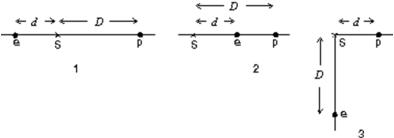
A)1, 2, 3
B)3, 2, 1
C)2, 3, 1
D)1 and 2 tie, then 3
E)1 and 3 tie, then 2

A)1, 2, 3
B)3, 2, 1
C)2, 3, 1
D)1 and 2 tie, then 3
E)1 and 3 tie, then 2

Unlock Deck
Unlock for access to all 55 flashcards in this deck.
Unlock Deck
k this deck
50
Points R and T are each a distance d from each of two equal positive charges as shown.If k = 1/4  , the work required to move a particle with a charge q from R to T is:
, the work required to move a particle with a charge q from R to T is: 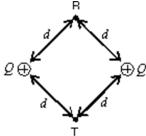
A)0
B)kQq/d2
C)kQq/d
D)
E)kQq/(2d)
 , the work required to move a particle with a charge q from R to T is:
, the work required to move a particle with a charge q from R to T is: 
A)0
B)kQq/d2
C)kQq/d
D)

E)kQq/(2d)

Unlock Deck
Unlock for access to all 55 flashcards in this deck.
Unlock Deck
k this deck
51
A solid metal sphere carries a charge of 5 *10-9 C and is at a potential of 400 V, relative to the potential far away.The potential at the center of the sphere is:
A)400 V
B)-400 V
C)2 * 10-6 V
D)0 V
E)none of these
A)400 V
B)-400 V
C)2 * 10-6 V
D)0 V
E)none of these

Unlock Deck
Unlock for access to all 55 flashcards in this deck.
Unlock Deck
k this deck
52
Two conducting spheres are far apart.The smaller sphere carries a total charge of Q.The larger sphere has a radius that is twice that of the smaller and is neutral.After the two spheres are connected by a conducting wire, the charges on the smaller and larger spheres, respectively, are:
A)Q/2 and Q/2
B)Q/3 and 2Q/3
C)2Q/3 and Q/3
D)0 and Q
E)2Q and -Q
A)Q/2 and Q/2
B)Q/3 and 2Q/3
C)2Q/3 and Q/3
D)0 and Q
E)2Q and -Q

Unlock Deck
Unlock for access to all 55 flashcards in this deck.
Unlock Deck
k this deck
53
Two conducting spheres, one having twice the diameter of the other, are separated by a distance large compared to their diameters.The smaller sphere (1)has charge q and the larger sphere (2)is uncharged.If the spheres are connected by a long thin wire and come to equilibrium: 
A)1 and 2 have the same potential
B)2 has twice the potential of 1
C)2 has half the potential of 1
D)1 and 2 have the same charge
E)all of the charge is dissipated

A)1 and 2 have the same potential
B)2 has twice the potential of 1
C)2 has half the potential of 1
D)1 and 2 have the same charge
E)all of the charge is dissipated

Unlock Deck
Unlock for access to all 55 flashcards in this deck.
Unlock Deck
k this deck
54
A conducting sphere with radius R is charged until the magnitude of the electric field just outside its surface is E.The electric potential of the sphere, relative to the potential for away, is:
A)0
B)E/R
C)E/R2
D)ER
E)ER2
A)0
B)E/R
C)E/R2
D)ER
E)ER2

Unlock Deck
Unlock for access to all 55 flashcards in this deck.
Unlock Deck
k this deck
55
Points R and T are each a distance d from each of two particles with charges of equal magnitudes and opposite signs as shown.If k = 1/4  , the work required to move a particle with negative charge q from R to T is:
, the work required to move a particle with negative charge q from R to T is: 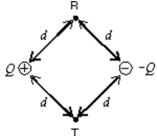
A)0
B)kqQ/d2
C)kqQ/d
D)
E)kQq/(2d)
 , the work required to move a particle with negative charge q from R to T is:
, the work required to move a particle with negative charge q from R to T is: 
A)0
B)kqQ/d2
C)kqQ/d
D)

E)kQq/(2d)

Unlock Deck
Unlock for access to all 55 flashcards in this deck.
Unlock Deck
k this deck


